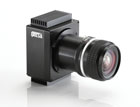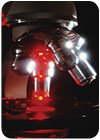
Color provides more visual detail than monochrome grayscale and adds a new dimension in analyzing data in the real world. Source: Dalsa
Machine vision has evolved to become a fast and reliable tool for quality inspection. In many cases, a machine vision optical inspection system can perform quality inspections more quickly and accurately than humans and at a lower cost. However, can a machine “see” in color? And does introducing color into the equation help with quality inspection?
A machine vision system acquires images of an object with a camera and then uses computers to process, analyze and measure various characteristics of that object so decisions can be made. One of the characteristics analyzed can be an object’s color.
In the past, color has not been widely used in optical inspection because of the cost and processing power required. However, as costs decrease and processing power ceases to be an issue, solutions providers are looking to incorporate color into machine vision optical inspection systems to yield greater quality.

Many applications require color and the trend for color is increasing. Source: Dalsa
Is Color Better?
The basic assumption is that color is more advanced than black and white, or monochrome, so it must be better. However, this assumption is not always true in machine vision. In typical inspection applications where defects such as cracks or scratches are detected, the use of color is not necessary because the goal is to discern a difference in lightness on the object’s surface.There also are some things that monochrome cameras do better than color cameras. Take resolution and speed, for example-there are more choices in high resolution and high speed when shopping for monochrome cameras. In addition, there are many cases where color images do not offer any advantage over monochrome images in resolving a machine vision problem, such as Optical Character Recognition (OCR), Optical Character Verification (OCV), bar code reading, gaging and other applications that are dependent on high-resolution spatial information.
Machines See in Color
Of course, a machine cannot actually see in color. Machines use mathematical models to approximate human color detection. A machine can be calibrated against the average human response to color and hence “see” in that it gives consistent responses to colors observed in a controlled setting. This calibrated color vision is useful for measuring and matching colorants in paint, plastics and fabrics. We do not think of this as seeing color like a human, except perhaps as a philosophical exercise. However, it is important to make the distinction between the relative measurements that can be made with a machine vision system vs. absolute measurements that are only possible with devices such as photospectometers.Human color vision evolved to reliably extract information about the material properties of objects seen under huge variations of illumination and view. For example, fruit color has to be reliably determined despite varying illumination to pick ripe from unripe or bad fruit. Human color vision has mechanisms to factor out variations in illumination and view that we do not know how or do not bother to put into machine color vision. Human color vision is relative. Nearby colors influence the perception of a color, it has low resolution-a fact used to transmit color in television with very little bandwidth-and there are wide differences between individuals. Thus it is not a good measuring tool.
Machine color vision is not influenced by nearby colors, can have high resolution, does not vary much from machine to machine, and thus is a good measuring tool.

A machine vision system acquires images of an object with a camera and then uses computers to process, analyze and measure various characteristics of that object. Source: Dalsa
Types of Color Systems
Most color machine vision systems use a mix of hardware and software to detect colors. For point or spot color measures, a solution predominantly made up of hardware is suitable. Sophisticated detection systems rely more heavily on software to give flexibility to designers and operators.The main types of color cameras used in machine vision applications are 3CCD (charge-coupled device), tri-linear and Bayer pattern cameras. 3CCD has excellent color registration and can be applied to the majority of applications. However, the cost is high due to the design.
Tri-linear provides high performance and has advantages in terms of its low-cost. It can be used in many applications such as flat surface inspection. However, spatial correction cannot be done correctly in certain applications that involve rotating or randomly moving objects.
Finally, Bayer pattern cameras round out the mix offering the lowest cost solution. These cameras are not recommended if color precision is the most important aspect of the application.
Aside from the obvious applications where the color of an object needs to be evaluated in some way, color can sometimes help to make an inspection situation easier by facilitating the identification of objects, such as in the verification of fuses’ values in car fuse boxes.
Should color eventually be used in all machine vision applications? No. When faced with an application that instills some doubt, ask the following questions:
- Is the object’s color quality and consistency a key factor in the overall quality of the product?
- Can the object’s color help to ascertain the relative quality of the product?
- color facilitate detection of the object?
Applications
Let’s look at a real-world application that will help facilitate the decision of whether or not color should be part of the application. Color machine vision is used in automotive inspection. Although one may think that a car’s paint would be where machine vision is used, the bulk of the effort goes into inspecting the fine visual details that make up the user interface, such as the consistency and evenness of the instrument-cluster light panel. This is important because the look and overall quality of the instrument-cluster and dashboard go a long way toward contributing to the driver’s impression of a car’s quality.Obviously, there many other applications that require color, such as print inspection (quality/registration), pharmaceutical inspection (label verification), part presence and detection, PCB assembly (part presence, verification and placement). In addition, there is a slew of quality and grading applications that involve color and texture classification for things such as wood, textiles and ceramic tile.
The Future of Color
The Automated Imaging Association (AIA) market studies show that only about one-fourth of cameras sold for imaging applications in 2005 and 2006 were color cameras with the remaining three-fourths as monochrome, but the trend for color is moving upward.Most experts believe the use of color will expand in machine vision. Color provides more visual detail than monochrome grayscale and adds a new dimension in analyzing data in the real world.
Better color fidelity, lower cost and ease-of-use are the primary drivers in the market and new technologies being developed in the near future to address these needs and to meet the increasing demand of these products.Q

What Types of Color Machine Vision Cameras Exist?
The main types of color cameras used in machine applications are 3CCD, tri-linear and Bayer pattern cameras. These can be either area scan or line scan cameras depending upon the type of color incorporated.3CCD has excellent color registration and can be applied to the majority of applications. However, the cost is higher due to the design. In a 3CCD color camera, color is selected using a prism-based interference filter that splits the incoming light into Red (R), Green (G) and Blue (B) primary components. Each of the three primary colors is then detected by a CCD respectively and the final color image is reconstructed by combining the outputs from the three CCDs. All three color images are captured at the same object spot and at the same time.
Tri-linear provides high performance and has advantages in terms of its low cost. It can be used in many applications such as 100% print inspection. However, spatial correction cannot be done properly in certain applications that involve rotating or randomly moving objects. In a tri-linear color camera, three linear arrays are fabricated on one single die and coated with RGB color filters respectively. These are absorbing filters using dye or pigment. In the tri-linear camera, the three linear arrays detect a slightly different field of view (FOV) of the object and spatial correction is needed in the reconstruction of a color image.
Finally, Bayer pattern cameras round out the mix offering the lowest cost solution. These cameras tend to be used in lower-end applications and have reduced color precision as compared to 3CCD and tri-linear cameras. However, there is broad understanding of the Bayer pattern and many algorithms exist to optimize its color performance.


